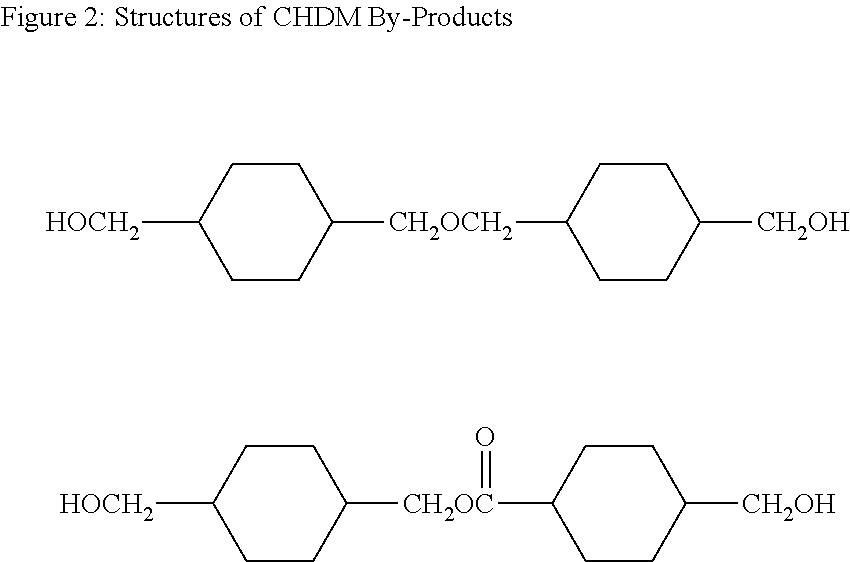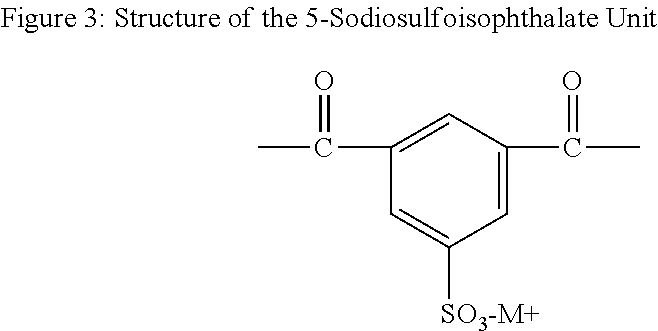DiCHDM COPOLYESTERS
- Summary
- Abstract
- Description
- Claims
- Application Information
AI Technical Summary
Benefits of technology
Problems solved by technology
Method used
Image
Examples
examples
1. General Synthesis Example to Obtain a High Molecular Weight Amorphous Polyester
[0056]A 500 mL round bottom flask equipped with a ground glass head, agitator shaft, nitrogen inlet, and a sidearm to allow for removal of volatile materials was charged with 97 grams (0.50 moles) dimethyl terephthalate, 57.1 grams (0.92 moles) ethylene glycol, 22 grams (0.08 moles) diCHDM, and 0.86 mL of a 0.985% (w / v) solution of titan ium(IV)isopropoxide in n-butanol. The flask was purged 2× with nitrogen and immersed in a Belmont metal bath at 200° C. for 60 minutes and 210° C. for an additional 60 minutes under a slow nitrogen sweep with agitation. After increasing the temperature to 280° C., a vacuum of g) of 75° C.; a melting point (Tm) was not detected.
[0057]PET for fibers is typically obtained in a melt phase only process where an IhV of g and melting point.
2. Fiber Grade PET with diCHDM Comonomer
[0058]The apparatus described in Example 1 was charged with 97 grams (0.50 moles) dimethyl terepht...
example 4
Shows that a Polyester can be Synthesized using diCHDM as the only Diol
[0060]4. Copolyester Containing diCHDM as the Only Diol
[0061]The apparatus described in Example 1 was charged with 97 grams (0.50 moles) dimethyl terephthalate, 141.9 grams (0.53 mole) diCHDM, and 1.53 mL of a 0.98% (w / v) solution of titan ium(IV)isopropoxide in n-butanol. The flask was purged 2× with nitrogen and immersed in a Belmont metal bath at 240° C. for 60 minutes under a slow nitrogen sweep with agitation. After increasing the temperature to 270° C., a vacuum of 0.3 mm was attained and held for 61 minutes to complete the polycondensation. The vacuum was displaced with nitrogen and the clear, amber polymer melt was allowed to cool before removal from the flask. An inherent viscosity of 0.28 was obtained for the recovered polymer according to ASTM D3835-79 at a concentration of 0.5 g / 100 mL solvent. Thermal analysis by DSC yielded a 2nd cycle glass transition temperature (Tg) of 51° C.
example 5
Illustrates that a High Molecular Weight Copolyester can be Obtained with a High Level of diCHDM
[0062]5. Amorphous Copolyester with 80% diCHDM
[0063]The apparatus described in Example 1 was charged with 97 grams (0.50 moles) dimethyl terephthalate, 33 grams (0.53 moles) ethylene glycol, 108 grams (0.40 moles) diCHDM, and 1.37 mL of a 0.98% (w / v) solution of titan ium(IV)isopropoxide in n-butanol. The flask was purged 2× with nitrogen and immersed in a Belmont metal bath at 200° C. for 60 minutes and 220° C. for an additional 60 minutes under a slow nitrogen sweep with agitation. After increasing the temperature to 260° C., a vacuum of 0.3 mm was attained and held for 22 minutes to complete the polycondensation. The vacuum was displaced with nitrogen and the clear, amber polymer melt was allowed to cool before removal from the flask. An inherent viscosity of 0.80 was obtained for the recovered polymer according to ASTM D3835-79 at a concentration of 0.5 g / 100 mL solvent. NMR analysis ...
PUM
 Login to View More
Login to View More Abstract
Description
Claims
Application Information
 Login to View More
Login to View More - R&D
- Intellectual Property
- Life Sciences
- Materials
- Tech Scout
- Unparalleled Data Quality
- Higher Quality Content
- 60% Fewer Hallucinations
Browse by: Latest US Patents, China's latest patents, Technical Efficacy Thesaurus, Application Domain, Technology Topic, Popular Technical Reports.
© 2025 PatSnap. All rights reserved.Legal|Privacy policy|Modern Slavery Act Transparency Statement|Sitemap|About US| Contact US: help@patsnap.com



